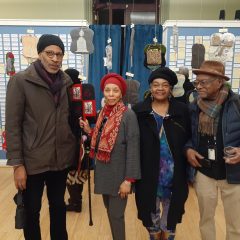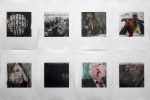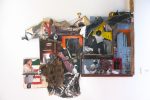A few weeks ago I had the privilege of installing the works of Leroy Johnson in the galleries of Isaiah Zagar’s sprawling South Street creation, Philadelphia’s Magic Gardens (I have worked here as a guide and preparator). You wouldn’t think that in this particular setting—where mosaicked materials creep over each and every surface, from bathroom cabinets, across ceilings and floors, and out into a labyrinthine garden—that a lineup of works on paper and small sculptures would be able to get a word in edgewise. But the pieces by native Philadelphian Leroy Johnson that line the walls of his one-man show read more like a motion-picture than like still works. They literally roar with kinetic and frenetic energy of their subject matter: traversing, inhabiting and navigating urban space, and specifically, the streets of Philadelphia.
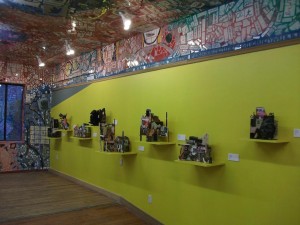
The works of these two long-time Philadelphians, Zagar and Johnson, presented woven together like a jigsaw puzzle, are not only a treat for the mind and eyes, but are a collaborative testament to the influence and importance of the muse Philadelphia who has guided the hands of these two artists throughout their careers. Zagar’s constant motto, “Art is the center of the real world, and Philadelphia is the center of the art world,” also rings true for Johnson, whose eloquent yet raw paintings and sculptures wrangle–from the buzzing and whirring, the trash, transportation, debris, noises and sights of our dirty city–nothing less than poetry.
The majority of the works on paper (or more specifically: works on old movie posters) in this show draw from Johnson’s daily experience of riding the Frankford Market Line train from his home in West Philly to his studio just north of Center City. Linear renderings of train cars, underpasses, and other industrial architecture form sturdy and even classical compositional frameworks for these pieces, but also create a jumping-off point for the more manic and organic elements that spew forth: collaged photographs and scrawled drawings of huddled figures, torn advertisements, graffiti, neon store signs and smoggy, far-off views. These works speak of ingrained visual experience: sites, sounds, textures, shapes so familiar as to have become part of the artist’s natural visual language. His paintings are the murmurs, grunts, sighs and shouts of this experience, the glints and glimmers of views from the elevated train, the quick glances at passing strangers and street signs, the voices of neon and posters (cornbread! fried chicken!), panhandlers and radios, whose cries seep into our unconscious experience of traversing space, of going home. His works present this experience as both personal and universal, unique and also ubiquitous—specific to Johnson’s lived visual vernacular, yet familiar to any open-eyed city dweller.
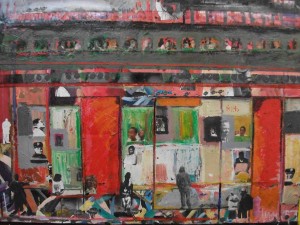
The exhibition also contains small sculptures by Johnson—Joseph Cornell-like boxes or houses made from found objects, trash, ceramic pieces, newspaper clippings and paint. These pieces deal more explicitly with themes of racial violence and inequality, poverty and decrepitude. They are less visually stunning, more quietly disturbing: a little girl’s face on one side of the dollhouse is abutted by the scene of a lynching on the other side. These works transmit a greater sense of history and of the private, forgotten or secret stories that haunt the abandoned homes and boarded-up buildings scattered generously throughout Philadelphia. They are less impressionistic and more probing—less about a visual language of space and more about its excavation and airing out.
Johnson’s works are not beautiful in any immediate sense—they have the dripping grit and grime of a Dubuffet or of the damp corners of a Septa station. Yet through the gobs of paint and slimy mediums and scabrous peeling paper, we feel a carefully curated, belching and breathing life—of the artist, of his city, and of the scenes and people and places that find their way into his works. Although we may try to ignore this life as we experience it in our own lives—the urban decay and poverty that afflict primarily African Americans in this city and in many others—Johnson’s work resurrects it and brings it to the fore, and performs on it neither cloying criticism nor cool aestheticization, but rather extracts from it an earnest, and sometimes even jubilant, record of experiential lived thought. The opportunity to view Leroy Johnson’s work inside the bellowing beast of Isaiah Zagar’s is not to be missed; the ensemble inspires us all to recognize the impact of our surroundings and fellow inhabitants on they way we think, see and live.
Remnants of a City: Leroy Johnson’s Philadelphia, on view now at Philadelphia’s Magic Gardens.
Public Reception: Friday, January 28, 6:00 PM – 9:00 PM



